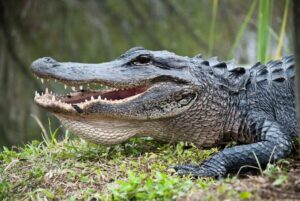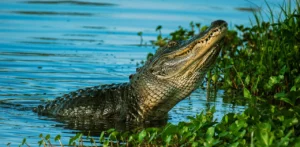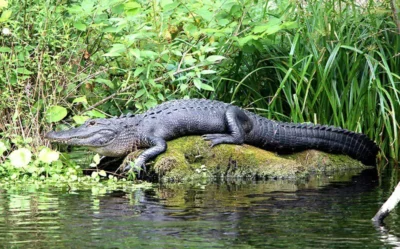Ever found yourself pondering the peculiar question: “How high can alligators jump?” Well, it turns out these reptilian creatures have a surprising ability to propel themselves out of the water with unexpected agility.
While it’s challenging to pinpoint an exact figure due to the variability among individual alligators, their jumping capabilities generally range from a few feet to around 2-3 feet (60 to 90 centimeters) in height.
Larger alligators might achieve slightly higher jumps to 6 feet, but the nature of their musculature and body structure limits them from executing truly remarkable leaps.
So, in this article, we will delve into the factors that determine just how high these scaly jumpers can soar. From their powerful tails to the physics of their jumps, we’re about to unravel the mysteries behind the impressive vertical leaps of these fascinating creatures.
How high can alligators jump?

Alligators are surprisingly impressive jumpers! Their powerful tails and strong muscles allow them to launch themselves out of the water or off the ground to reach surprising heights. Here’s what you can expect:
Out of the water:
- Up to 6 feet: This is the maximum recorded jump height for an alligator, although most average around 4-5 feet.
- Catching prey: They use this amazing ability to snatch unsuspecting birds, bats, or even tree-dwelling mammals that venture too close to the water’s edge.
- Reaching high objects: They can also jump to grab food hanging from overhanging branches or climb onto platforms for basking in the sun.
On land:
- Less impressive: While not their forte, alligators can still jump a decent height on land, typically around 2-3 feet.
- Defense: They might use this to chase after prey on land or even defend themselves from potential threats.
Importance of understanding alligator behavior
Understanding alligator behavior is crucial for several reasons, especially for individuals who live or work in areas where alligators are present. Here are some key reasons highlighting the importance of understanding alligator behavior:
- Safety: Alligators are powerful predators and can be dangerous to humans. Understanding their behavior helps people avoid potentially risky situations. For example, knowing when alligators are most active, their preferred habitats, and their typical behavior during mating season can help individuals take precautions and reduce the risk of dangerous encounters.
- Conservation: Alligators play a vital role in the ecosystem as top predators. Understanding their behavior is essential for conservation efforts. Knowledge of their feeding habits, nesting preferences, and overall behavior helps conservationists develop effective strategies to protect alligator populations and their habitats.
- Human-Wildlife Conflict Mitigation: In areas where humans and alligators coexist, conflicts can arise. Understanding alligator behavior helps in implementing measures to prevent conflicts, such as properly securing trash, managing water bodies, and establishing guidelines for human behavior in alligator habitats. This knowledge contributes to peaceful coexistence between humans and alligators.
- Environmental Management: Alligator behavior is closely tied to the health of wetland ecosystems. By understanding how alligators interact with their environment, researchers and environmentalists can assess the overall health of ecosystems and make informed decisions regarding habitat conservation and restoration.
- Tourism and Recreation: In regions where alligators are a part of the natural environment, understanding their behavior is essential for tourism and recreational activities. Tour operators, park managers, and outdoor enthusiasts can provide a safer and more enjoyable experience when they are aware of alligator behavior and implement appropriate safety measures.
- Research and Education: Studying alligator behavior contributes to our broader understanding of reptilian behavior, ecology, and evolution. This knowledge is valuable for scientific research and educational purposes. It helps researchers unravel the mysteries of these ancient creatures and fosters a deeper appreciation for biodiversity.
- Legal and Regulatory Purposes: Understanding alligator behavior is crucial for developing and implementing effective wildlife management policies and regulations. This knowledge informs decisions about hunting seasons, population management, and habitat protection, ensuring the sustainable coexistence of alligators and humans.
Alligator Jumping Abilities

Alligators are not known for their jumping abilities in the same way that some other animals, like big cats or deer, are. Alligators are primarily adapted for life in aquatic environments, and their physical characteristics are more specialized for swimming and ambushing prey in the water. However, they do have some capabilities related to vertical movement:
- Vertical Leap: Alligators are capable of making short bursts of vertical movement, especially when lunging at prey or attempting to catch something above the water surface. They can push themselves up and out of the water to some extent, but this is typically a quick and forceful action rather than a sustained jump.
- Bursts of Speed: While not a traditional jump, alligators are known for their powerful bursts of speed, particularly in the water. They can swim quickly to catch prey or escape potential threats. On land, their movement is more cumbersome, and they are not built for sustained running or jumping.
- Ambushing Technique: Alligators are skilled ambush predators. They often remain submerged with only their eyes and nostrils above the water, waiting for prey to approach. When they decide to strike, they can quickly launch themselves from a concealed position to catch their prey by surprise.
Additionally, alligators are ectothermic (cold-blooded) animals, and their physical capabilities are influenced by environmental conditions, such as temperature. They are generally more active and agile in warmer temperatures.
While alligators may exhibit some degree of vertical movement, it’s not comparable to the jumping abilities of animals adapted for leaping or climbing. Alligators are better adapted for stealthy movement in water and rely on their powerful jaws, strong tails, and well-developed senses to capture prey and navigate their surroundings.
Factors influencing jumping capabilities

Factors Influencing Alligators Jumping Heights
Alligators are known for their powerful and agile movements, both in water and on land. While they are not typically associated with jumping like some other animals, they can exhibit impressive vertical movements under certain circumstances. Factors influencing alligators’ jumping heights include:
- Muscle Strength and Power: The ability of alligators to jump is closely tied to their muscle strength and power. Strong hind limb muscles play a significant role in generating the force needed for vertical jumps.
- Size and Age: Larger and older alligators may have more developed muscles and greater strength, potentially allowing them to achieve higher jumps. Younger alligators may not have fully developed musculature and may not jump as high.
- Environmental Conditions: The environment in which an alligator is attempting to jump can influence its performance. For example, a dry and solid surface may provide better traction and push-off for a jump compared to a wet or slippery surface.
- Territorial or Defensive Behavior: Alligators may jump as a form of territorial display or in a defensive manner when threatened. The height of the jump in these situations may be influenced by the perceived level of threat and the need to establish dominance.
- Individual Variation: Just like in any animal population, there can be significant individual variation in physical abilities. Some alligators may naturally be better jumpers than others due to genetic or developmental factors.
- Health and Physical Condition: An alligator’s overall health and physical condition can impact its ability to jump. Injuries or health issues may limit an alligator’s jumping capabilities.
- Motivation and Stimulus: Alligators may jump in response to specific stimuli, such as the presence of prey, a potential mate, or a perceived threat. The motivation behind the jump can influence the height reached.
- Water Depth: While alligators are more commonly associated with swimming than jumping, the depth of the water can influence their ability to launch themselves vertically. Shallow water may provide a better platform for jumping compared to deep water.
Conclusion
You can learn more about how high can alligators jump on this page. Alligators are not known for their jumping abilities. While they can exhibit impressive bursts of speed on land and in water, their vertical jumping capability is limited.
Typically, alligators are more adept at swimming and crawling than leaping, and their anatomy is not designed for significant jumps. In summary, alligators are not considered high jumpers, and their primary modes of locomotion involve sliding into the water or navigating on land with powerful, low-to-the-ground movements.

